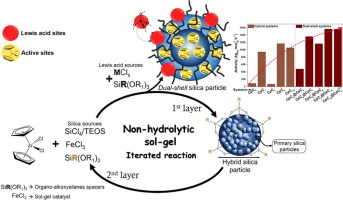Journal of Catalysis ( IF 6.5 ) Pub Date : 2020-03-19 , DOI: 10.1016/j.jcat.2020.03.001 Marcius A. Ullmann , João H.Z. dos Santos

|
Cp2ZrCl2 was entrapped in dual-layered silica by two iterated nonhydrolytic sol-gel steps with organosilanes (methyltriethoxysilane, isopropyltriethoxysilane, octyltriethoxysilane, octadecyltrimethoxysilane) and WCl6 as modifiers. For comparative reasons, organic-inorganic hybrid one-layer systems were also synthesized. The hybrid systems were evaluated for ethylene polymerization, with methylaluminoxane (MAO) as the cocatalyst. Increasing catalytic activity was observed in the case of the dual-layered silica systems. Modification of the silica surface with octadecylsilane (C8-Si) in combination with the presence of added Lewis acid centers (W) afforded the highest catalytic activity among the systems tested. The presence of organosilanes on the silica surface may affect polyethylene polydispersity. In the case of dual systems, the presence of two distinct hybrid silica layer effects, an internal silica layer modified with C18-Si and an external layer with C8-Si moieties, impinged on the broadening of polydispersity. Inverse moieties have distinct polydispersity indexes that indicate the surface modification at internal/external silica layers affects polymer characteristics. Microstructural features of hybrid silicas determined by small-angle X-ray scattering indicate that a low number of neighbors and larger correlation distances could explain higher catalytic activities. Similarly, long carbon chains in organoalkoxysilanes tend to reduce the radii of second level particles in a hierarchical structure of dual-shell systems, which in turn leads to higher catalytic activity.
中文翻译:

通过非水解溶胶-凝胶法将锆茂固定化为有机-无机双壳二氧化硅用于生产聚乙烯
通过两个迭代的非水解溶胶-凝胶步骤,使用有机硅烷(甲基三乙氧基硅烷,异丙基三乙氧基硅烷,辛基三乙氧基硅烷,十八烷基三甲氧基硅烷)和WCl 6将Cp 2 ZrCl 2截留在双层二氧化硅中作为修饰符。由于比较的原因,还合成了有机-无机杂化单层系统。用甲基铝氧烷(MAO)作为助催化剂评估了杂化体系的乙烯聚合反应。在双层二氧化硅体系的情况下观察到增加的催化活性。用十八烷基硅烷(C8-Si)对二氧化硅表面的改性以及添加的路易斯酸中心(W)的存在提供了测试系统中最高的催化活性。二氧化硅表面上有机硅烷的存在会影响聚乙烯的多分散性。在双体系的情况下,存在两种不同的杂化二氧化硅层效应,即用C18-Si改性的内部二氧化硅层和具有C8-Si部分的外部层,影响了多分散性的扩大。反向部分具有独特的多分散指数,表明内部/外部二氧化硅层的表面改性会影响聚合物的特性。通过小角度X射线散射确定的杂化二氧化硅的微观结构特征表明,邻位数量少和相关距离大可以解释较高的催化活性。类似地,有机烷氧基硅烷中的长碳链往往会降低双壳系统分级结构中二级粒子的半径,进而导致更高的催化活性。通过小角度X射线散射确定的杂化二氧化硅的微观结构特征表明,邻位数量少和相关距离大可以解释较高的催化活性。类似地,有机烷氧基硅烷中的长碳链往往会降低双壳系统分级结构中二级粒子的半径,进而导致更高的催化活性。通过小角度X射线散射确定的杂化二氧化硅的微观结构特征表明,邻位数量少和相关距离大可以解释较高的催化活性。类似地,有机烷氧基硅烷中的长碳链往往会降低双壳系统分级结构中二级粒子的半径,进而导致更高的催化活性。










































 京公网安备 11010802027423号
京公网安备 11010802027423号